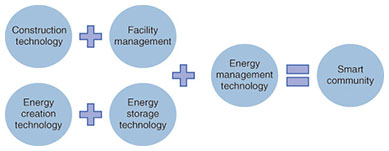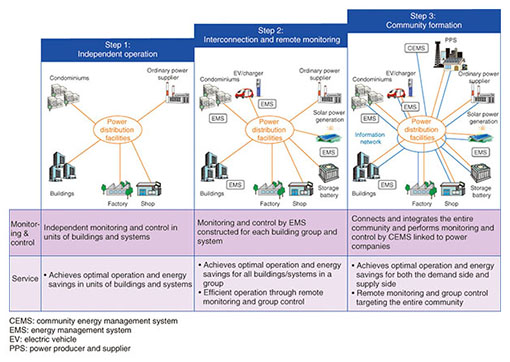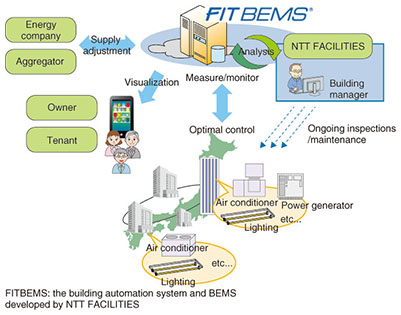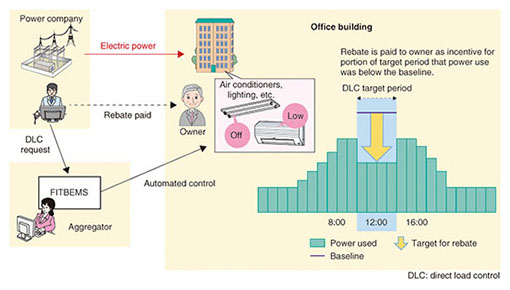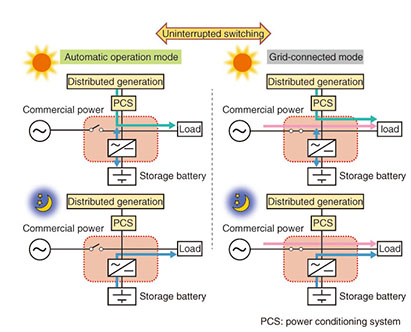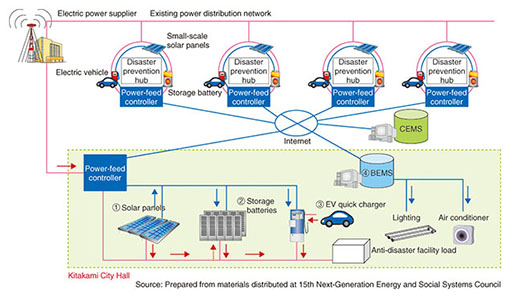 |
|||
|
|
|||
|
Feature Articles: R&D Efforts at NTT FACILITIES Vol. 12, No. 11, pp. 67–73, Nov. 2014. https://doi.org/10.53829/ntr201411fa11 Energy Management Technology for Smart CommunitiesAbstractVarious energy-saving efforts are now being made throughout Japan not just to put a brake on global warming but also to stabilize the supply and demand of electric power and to reduce the escalating energy prices in the wake of the Great East Japan Earthquake. In particular, the construction and arrangement of smart communities is now being promoted as an effective energy-saving solution. A smart community must be able to perform integrated management of electric power and other energy sources including thermal energy and untapped energy for various types of consumer facilities such as homes and office buildings. This article introduces key issues surrounding the smart community and essential elemental technologies and presents a case study of an actual implementation. Keywords: smart community, cloud-based xEMS, supply and demand optimization 1. IntroductionSince the Great East Japan Earthquake of 2011, extensive efforts have been made in Japan to save power in order to cope with the severe situation regarding the supply and demand of electricity. This situation not only hinders everyday life but also corporate productivity and business activities, and there are concerns that it may even lower the quality of human life. The need for power-saving measures during times of peak power consumption such as in the summer and winter seasons has consequently become an issue of concern throughout society. A smart community is a social infrastructure that combines information and communication technology (ICT) and various types of energy-related technologies to enable people to lead safe and comfortable lives while considering the needs of the global environment. Through the use of ICT, smart communities aim to provide a stable supply of power from solar power generation, wind power generation, and other renewable energy sources that fluctuate in output. They also seek to optimally manage the demand generated by ordinary households and office buildings through the use of storage batteries and other measures. A smart community is a social system that can provide an adequate supply of energy without waste through the formation of a network of diverse energy-related devices and the visualization of the power generation and power consumption of those devices. 2. Steps toward achieving smart communitiesThe concept of the smart community has spread throughout the world from developed to emerging nations, and a variety of technical proposals and standards have been formulated from diverse sectors in society including the government, public institutions, and private enterprises in each country. Against this background, NTT FACILITIES seeks to contribute to the creation of smart communities and a future society that can provide a safe, comfortable, and environmentally conscious supply of energy. The company plans to accomplish this by bringing together a wide range of technologies combining ICT, power, and construction that have been accumulated over many years at NTT from the early days of Nippon Telegraph and Telephone Public Corporation to the present (Fig. 1).
The smart community forms a society that targets not only independent, scattered facilities such as residences and buildings but also an entire area for the deployment of a smart system. Achieving a smart community takes several steps, as shown in Fig. 2.
The first step is to perform monitoring and control that can achieve energy savings and optimal operation for each building, system, and device. The next step is to interconnect those nodes via an Internet protocol (IP) network to perform remote monitoring and control and achieve optimal operation for each group of buildings and systems. The final step is to build a smart community that integrates the elements of the entire community. 3. Elemental technologies of a smart communityA smart community consists of many elements including consumer premises such as homes and office buildings, consumer facilities such as various types of equipment (air conditioners, lighting, etc.) and electric vehicles (EVs), and energy-supply facilities such as solar power generators and power generating stations. These elements need to be managed in an integrated manner. In the following, we introduce NTT FACILITIES’ approach to achieving a smart community. 3.1 Position of office buildings in a smart communityConsumer premises in a smart community must be connected to a network and be active in dispatching information to the outside while being appropriately controlled in accordance with requests from the supply side. Energy management systems such as the home energy management system (HEMS) and building and energy management system (BEMS) can provide the technology needed to meet these requirements. Among consumer premises, it is extremely important that office buildings in particular be controlled owing to the following features that set them apart from homes.
Despite these features, it has not been very common in the past to connect office buildings to the outside world and to control their energy demands for the following reasons.
Recently, however, it has become possible to make BEMSs compatible with IP networks and open-system technologies. In this way, BEMSs will be able to contribute to the stabilization and optimization of energy supply and demand in buildings and in smart communities. 3.2 Cloud-based BEMS and automatic demand response (ADR)The usual practice in the BEMS field was to sell maker-specific systems. As a consequence, the operation of these systems differed from building to building, and the systems themselves tended to be complicated and expensive. The end result was that systems of this type came to be deployed only in buildings of a certain scale or larger. NTT FACILITIES took this into consideration and decided to focus its efforts on providing a low-cost, highly functional building management service that separates the BEMS server function and makes it available for common use. This scheme negates the need for one company to install all system equipment in each building as long as highly reliable network facilities exist. The total service image of this system is shown in Fig. 3.
The deployment costs of this system are reduced, and advanced monitoring and control capabilities are provided because in each building, only the minimally required amount of equipment for operating that building (such as switches, detectors, and sensors) is installed, and the functions for monitoring and controlling the equipment (servers, centralized monitoring functions, etc.) are placed on the cloud for execution over an IP network. This is called a cloud-based BEMS. The conversion of BEMS to a cloud-based format has the following advantages in addition to reducing costs:
Demand response (DR) is a technique for temporarily suppressing the demand for power during times of tight electric-power supply-and-demand conditions; it is implemented by notifying consumers of changes in the price of electricity and offering them incentives for reducing power usage during peak periods designated by power companies or aggregators and shifting that use to other time periods. Efficient execution of DR requires prompt response to DR requests and reduction of the operations needed for DR execution. An effective mechanism for meeting these requirements is to provide an online connection between power-companies/aggregators and consumers and to execute DR automatically. In fiscal year 2013, NTT FACILITIES teamed up with ENNET Corporation to construct a system in which our FITBEMS® was connected online to the ENNET system (Fig. 4) and to hold a field trial of automatic demand response (ADR) using an actual building. This field trial was conducted to evaluate the results of prior simulations that quantified the amount of power demand that could be reduced by applying ADR and any subsequent effects on the indoor environment. The results revealed that halting the operation of air conditioners and other facilities in response to 35 ADR requests made over a one-year period reduced the power demand by 2074 kWh without affecting the indoor environment.
3.3 Composite renewable energy systemIt is necessary to provide a stable power supply even during times of commercial power outage as a disaster prevention measure. Likewise, from the viewpoints of saving energy and preserving the environment, there is a need for efficient energy-use techniques that can make maximum use of the output from clean distributed generation including solar power generation. As a forerunner to such a system, composite renewable energy systems have been developed, such as the one shown in Fig. 5. During normal, everyday operation, a composite renewable energy system reduces or shifts peak power demand through prioritized use of distributed generation, and at the time of a commercial power outage, it shifts immediately to automatic operation mode to deal with a long-term power outage through the use of distributed generation and storage batteries. Accordingly, if composite renewable energy systems are to be linked with xEMS* in the future, not only can they provide a stable and highly reliable power supply, but they also hold the possibility of becoming a key device in smart communities as a consumer-side facility that can coordinate energy supply and demand in a building or area.
3.4 Mega-solar systemsThe deployment of mega-solar systems has been expanding greatly in recent years, as they are an important source of power in smart communities. The collection of measurement data in a mega-solar system is generally done with the aim of monitoring the system’s output, which fluctuates according to the weather, and checking the health of the system. In the future, we can expect mega-solar systems to be increasingly reflected in the regional coordination of energy supply and demand and used in predicting power-generation levels in the system planning stage. 3.5 Cloud-based CEMSThe target of conventional energy management using ICT has been facility groups in specific areas such as BEMS in office-building areas, a mansion/condominium energy management system (MEMS) in condominium areas, and HEMS in home areas. However, to achieve comprehensive energy management across an entire community, there will be a need for a community energy management system (CEMS) that can collect demand-related information across such EMSs on the consumer side and absorb information from the power-grid and distributed-generation side. A smart community aims to promote the introduction of renewable energy, improve energy conservation through effective use of local energy, and achieve urban development that is robust against disasters, so we can expect CEMS to play a centralized role in optimizing energy supply and demand across the entire community. Furthermore, a CEMS implemented on the cloud provides a number of benefits; not only is it flexible to the addition or removal of power-consuming and power-generating facilities within the target area, but it also enables high-speed and close information exchange with other cloud-based consumer-side EMSs.
4. Case studyNTT FACILITIES is currently involved in constructing a smart community in Kitakami City, Iwate Prefecture. The purpose of this project is twofold: (1) introduce distributed sources of renewable energy in stages to existing facilities owned by the local government in order to increase the ratio of renewable energy used to power those facilities, and (2) achieve urban development that is robust against disasters (Fig. 6).
Within this smart community, the CEMS will be used to control the charging/discharging of storage batteries according to supply-and-demand conditions in the target area through the use of supply-and-demand management equipment. This approach will enable the provision of a high-quality, uninterruptible power supply. The CEMS will also be used to achieve load control via a BEMS. The development of this CEMS is now in progress and is scheduled to come online in fiscal year 2015. 5. Future activitiesIntegrated management of consumers and suppliers to achieve a safe and comfortable smart community is a pressing social problem. Looking to the future, we can expect the smart community to become an important technology domain that Japan will be able to take pride in as a global leader. NTT FACILITIES aims for early deployment of smart communities by coordinating the advanced information technologies, energy management technologies, and facility management technologies developed to date by the NTT Group and by analyzing and visualizing various types of information to achieve appropriate system control. A transition is already taking place from the trial phase to the actual business phase. In future research and development activities at NTT FACILITIES, we plan to incorporate more accurate forecasting techniques, develop supply-and-demand management and control techniques as well as diverse applications based on those forecasting techniques, and expand the types of facilities and equipment that can be added or connected to the system. We also plan to research and develop behavior-recognition and behavior-prediction techniques targeting community residents and building tenants using smart devices and sensor networks. NTT FACILITIES is committed to making ongoing contributions to the construction and optimal operation of smart communities. |
|||

